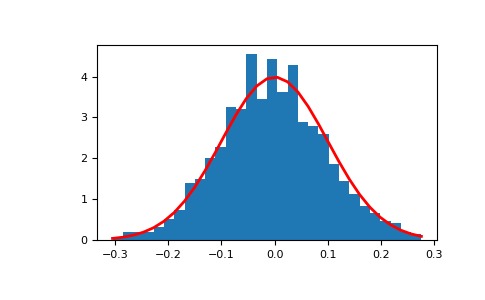用法:
RandomState.normal(loc=0.0, scale=1.0, size=None)从正态(高斯)分布中抽取随机样本。
正态分布的概率密度函数,首先由De Moivre提出,然后在200年后由Gauss和Laplace分别得出[2]由于其特征形状,通常称为钟形曲线(请参见下面的示例)。
正态分布通常在自然界中发生。例如,它描述了受大量微小随机干扰影响的样本的普遍分布,每种干扰都有其自己独特的分布[2]。
参数: - loc: : float 或 array_like of floats
分布的平均值(“centre”)。
- scale: : float 或 array_like of floats
分布的标准偏差(点差或“width”)。必须为非负数。
- size: : int 或 tuple of ints, 可选参数
输出形状。如果给定的形状是
(m, n, k), 然后m * n * k抽取样品。如果尺寸是None(默认),如果返回一个值loc和scale都是标量。除此以外,np.broadcast(loc, scale).size抽取样品。
返回值: - out: : ndarray或标量
从参数化正态分布中抽取样本。
注意:
高斯分布的概率密度为
哪里
是卑鄙的
标准偏差。标准差的平方,
,称为方差。
该函数的平均值处于峰值,并且其“spread”随着标准偏差的增加而增加(该函数在0.65倍时达到最大值)
和
[2])。这意味着
numpy.random.normal更有可能返回接近均值的样本,而不是相距较远的样本。参考文献:
[1] 维基百科,“Normal distribution”,https://en.wikipedia.org/wiki/Normal_distribution [2] (1,2,3)P. R. Peebles Jr.,“Central Limit Theorem”,“概率,随机变量和随机信号原理”,第四版,2001年,第51、51、125页。 例子:
从分布中抽取样本:
>>> mu, sigma = 0, 0.1 # mean and standard deviation >>> s = np.random.normal(mu, sigma, 1000)验证均值和方差:
>>> abs(mu - np.mean(s)) 0.0 # may vary>>> abs(sigma - np.std(s, ddof=1)) 0.1 # may vary显示样本的直方图以及概率密度函数:
>>> import matplotlib.pyplot as plt >>> count, bins, ignored = plt.hist(s, 30, density=True) >>> plt.plot(bins, 1/(sigma * np.sqrt(2 * np.pi)) * ... np.exp( - (bins - mu)**2 / (2 * sigma**2) ), ... linewidth=2, color='r') >>> plt.show()
来自N(3,6.25)的Two-by-four个样本数组:
>>> np.random.normal(3, 2.5, size=(2, 4)) array([[-4.49401501, 4.00950034, -1.81814867, 7.29718677], # random [ 0.39924804, 4.68456316, 4.99394529, 4.84057254]]) # random
相关用法
注:本文由纯净天空筛选整理自 numpy.random.mtrand.RandomState.normal。非经特殊声明,原始代码版权归原作者所有,本译文未经允许或授权,请勿转载或复制。
